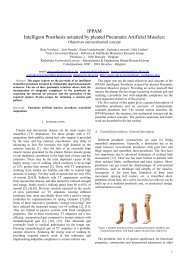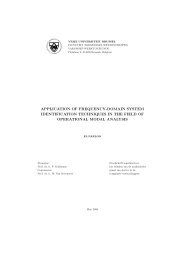VRIJE UNIVERSITEIT BRUSSEL Acoustics - the Dept. of ...
VRIJE UNIVERSITEIT BRUSSEL Acoustics - the Dept. of ...
VRIJE UNIVERSITEIT BRUSSEL Acoustics - the Dept. of ...
You also want an ePaper? Increase the reach of your titles
YUMPU automatically turns print PDFs into web optimized ePapers that Google loves.
4.2. REALIZATION OF ACOUSTIC ABSORPTION 69Thenarrower<strong>the</strong>poresare,<strong>the</strong>strongerwillbe<strong>the</strong>airfriction, thus<strong>the</strong>stronger <strong>the</strong> damping, i.e. absorption. In order to measure <strong>the</strong> acousticabsorption <strong>of</strong> a porous material an experiment can be conducted tomeasure <strong>the</strong> airflow through <strong>the</strong> material as shown in Figure 4.6. Thespecific air resistivity R s is a measure for this, defined by R s = −1vIt seems obvious that R s must be sufficiently large to achieve dampingand thus absorption. On <strong>the</strong> o<strong>the</strong>r hand R s should not be too large,because<strong>the</strong>n<strong>the</strong>poreswillbecometoonarrowandonlyasmallfraction<strong>of</strong> <strong>the</strong> incident intensity will penetrate, while <strong>the</strong> main part is reflected.The layer thickness is also an important parameter. Indeed, in orderto get a damped wave, it must penetrate a sufficient distance into <strong>the</strong>porous material. Moreover, <strong>the</strong> damping is proportional to <strong>the</strong> wavevelocity (and not <strong>the</strong> pressure) which has a maximum at a quarterwavelength away from <strong>the</strong> wall. One thus comes to <strong>the</strong> conclusionthat relatively low R s and relatively thick material should give rise t<strong>of</strong>avorable absorption properties. One should especially not think thathigh R s and small thickness give rise to good absorption. This cheapsolution leads to bad results.Frequency also plays a major role here, since <strong>the</strong> particle velocity dependson it. The friction losses, which are dependent on <strong>the</strong> viscosity,increase with increasing speed, thus increasing frequency <strong>of</strong> sound.Hence porous layers especially absorb high frequencies. Fur<strong>the</strong>r, onemayalso imaginethatalargelayer thickness isrequired toabsorblowerfrequency (large wavelength).The pore structure also plays a role (granular or fibrous material ...).The structure can be described by means <strong>of</strong> <strong>the</strong> so-called tortuosity(this is <strong>the</strong> randomness with which <strong>the</strong> fibers are arranged in <strong>the</strong> material).The method <strong>of</strong> fixation in front <strong>of</strong> <strong>the</strong> wall. If fixed on pr<strong>of</strong>iles, a fewcentimeters infront<strong>of</strong>ahardwall, <strong>the</strong>noneobtainsanabsorbenteffect,approximately equivalent to that <strong>of</strong> a layer absorbent material, equallyto <strong>the</strong> sum <strong>of</strong> <strong>the</strong> thickness <strong>of</strong> <strong>the</strong> air layer and <strong>the</strong> thickness <strong>of</strong> <strong>the</strong>absorbent material.Caution: paint covers <strong>the</strong> fine pores and annihilates <strong>the</strong> sound-absorbingeffect <strong>of</strong> porous materials (<strong>the</strong>re is no danger with large pores).Some numerical values <strong>of</strong> <strong>the</strong> specific flow resistivity : R s = 10 4 for glasswooland rockwool, R s = 10 5 for compact glasswool and compact rockwoolR s = 10 6 for compact fiberboard and R s = 10 7 for compact stony materials.∂p. ∂x
















